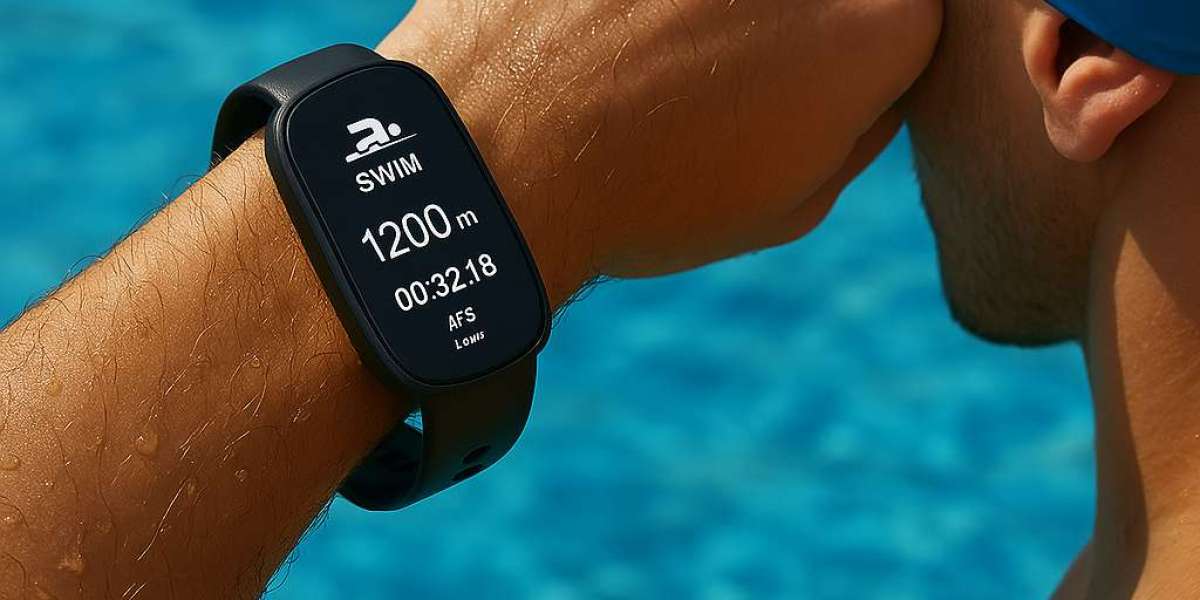Swimming is one of the healthiest sports. It works your whole body and improves heart, lung, and muscle strength. Whether you swim for fun, fitness, or competition, tracking your swim can help you get better over time. That’s why using a fitness tracker for swimmers is a smart choice.
These waterproof gadgets track your laps, strokes, heart rate, and swim time. Some even check how efficiently you swim. This helps you see your progress and know what to improve. A good fitness tracker for swimmers is like a helpful coach on your wrist. It supports your goals and makes swimming more fun and focused.
In this article, you’ll learn why tracking your swim matters, what to look for in a swim tracker, how they help your swimming technique, tips to pick the right one, the best trackers in the market, and how to use them properly.
Why Tracking Swim Workouts Matters
Many people jump into the pool and swim without knowing how far or how well they swim. But tracking your swim workouts helps you in many ways. A fitness tracker for swimmers gives you data on your swimming habits and performance. This data motivates you and shows your progress over time.
Swim trackers count your laps, measure distance, and track swim time. Some even detect which stroke you are using. Many fitness trackers show calories burned, split times, and rest intervals. All this information helps you build a better swim routine.
If you swim regularly for fitness, tracking helps set weekly or monthly goals. You can say, "This week, I will swim 1,000 meters every day." Seeing the numbers rise in your app is a big motivation.
Competitive swimmers can track improvements in speed, stroke rate, and efficiency. The tracker helps spot weak points. If you notice your strokes per lap are too high, you might be wasting energy. This lets you correct your form.
Overall, a tracker helps you swim with purpose. You stop guessing and start measuring. It builds discipline and creates better habits in the pool.
Best Features in a Swim Tracker
Not all fitness trackers are the same. When you look for a fitness tracker for swimmers, check if it’s made for use in water. The right features make all the difference in getting useful swim data.
1. Waterproof Rating: First, make sure it is waterproof. It should be safe up to at least 50 meters underwater (5 ATM). Some advanced models work in deeper water or open-water swims.
2. Swim Metrics: The tracker should give details like lap count, stroke count, swim time, distance, and SWOLF. SWOLF means “swim golf”—a score combining time and strokes per lap. A lower score means better swim efficiency.
3. Heart Rate Monitoring: Underwater heart rate is a newer feature but very useful. It shows how hard your heart is working. This is helpful for both fitness and training.
4. Stroke Recognition: Some trackers automatically detect if you are doing freestyle, breaststroke, backstroke, or butterfly.
5. Long Battery Life: A good tracker should last for several swim sessions. Look for ones that run 5 to 10 days on a full charge.
6. Easy-to-Read Display: Make sure the screen is clear and readable even underwater. Button-based or auto-screen trackers often work better than touchscreens in water.
7. Good App Support: The tracker should sync with a phone app that shows your swim history, helps set goals, and allows progress tracking.
Pick a tracker with features that match your swim level and your needs. More features are useful, but the best one is the one you’ll use regularly.
How Trackers Improve Swim Technique
One big reason to use a fitness tracker for swimmers is to improve your swimming technique. Even small changes in how you swim can make a big difference in speed, comfort, and stamina. Trackers help you notice those small changes.
For example, your tracker may show you take 30 strokes per 25 meters. That’s a lot. With better form, you could do it in 20 strokes. When you see this on the tracker, you know it's time to adjust.
Heart rate data also helps. If your heart rate is too high during a short swim, you may be swimming inefficiently. That means your body is working too hard. Better technique means smoother, more energy-saving swimming.
SWOLF scores are another tool. If your time and stroke count improve, your SWOLF score will drop. That shows you are becoming more efficient.
Stroke detection is useful too. It tells you if your strokes are consistent. If you're working on breaststroke but the tracker sees freestyle, then you may need to fix your stroke.
You can also look at trends over time. If you swim 100 meters faster than last month or use fewer strokes, that’s clear proof of improvement.
Trackers turn every swim into a lesson. You get instant feedback and clear insights. This helps both beginners and advanced swimmers get better.
Choosing the Right Tracker for You
With so many models available, picking the best fitness tracker for swimmers can feel confusing. But you can choose easily by focusing on a few key things.
1. Your Swim Goals: Are you swimming for health, weight loss, or training? For casual swims, basic trackers with lap counting may be enough. If you want detailed data, go for advanced models.
2. Budget: Fitness trackers range from ₹4,000 to ₹30,000 or more. More expensive doesn’t always mean better. Pick one with features you’ll actually use.
3. Comfort and Fit: The tracker should feel comfortable on your wrist. It shouldn’t be too heavy or loose. Some people prefer slim bands over bulky watches.
4. Battery Life: Longer battery life means fewer charges. Some swim-only trackers last a week. Smartwatches with swim features may last a day or two.
5. Mobile App: Choose a tracker with a good app. The app should be simple, easy to understand, and help you set and reach goals.
6. Other Activities: Do you also run, bike, or do yoga? If yes, a multi-sport tracker is better. It tracks your full day’s activity.
7. Brand Trust: Trusted brands like Garmin, Apple, Fitbit, Coros, and Samsung offer quality trackers. They also provide better customer support and regular updates.
Test different models if you can. Try to watch video reviews or read feedback from swimmers. The right tracker will fit your lifestyle and help you stay consistent.
Most Popular Swim Trackers Today
If you're ready to buy a fitness tracker for swimmers, here are some top options. They are trusted by swimmers around the world.
1. Garmin Swim 2:
Made for pool and open water
Tracks distance, pace, heart rate, and strokes
Great battery life (up to 7 days)
Accurate and easy to use
2. Apple Watch Series 9:
Stylish and smart
Detects stroke type and lap count
Tracks heart rate and calories
Syncs well with iPhone and Apple Health
Battery lasts 18–24 hours
3. Fitbit Charge 6:
Good for beginners
Tracks basic swim stats (lap and duration)
Light, comfortable band
Budget-friendly
4. Coros Pace 3:
Strong multi-sport support
GPS tracking for open water
Excellent battery life (20+ days)
High accuracy
5. Samsung Galaxy Watch 6:
Beautiful screen and smart features
Tracks swimming, heart rate, and sleep
Works well with Android phones
All of these trackers have something special. If you’re just starting, Fitbit Charge 6 is easy and affordable. For serious swimmers, Garmin Swim 2 or Coros Pace 3 give detailed performance data.
Tips to Use Your Tracker Effectively
Once you get your fitness tracker for swimmers, you need to use it correctly. This ensures you get accurate results and keep the device safe.
1. Adjust the Fit: Wear the tracker tight enough so it doesn’t move but not too tight to hurt. A loose fit can cause wrong readings.
2. Set Pool Length: Before swimming, set the correct pool size (like 25 or 50 meters). This helps the tracker count laps correctly.
3. Rinse After Swimming: After every swim, rinse your tracker with clean water. Chlorine or salt can damage it over time.
4. Sync Daily: After each swim, sync your data with the app. This way you don’t lose any progress and can track long-term improvement.
5. Charge Smartly: Charge your tracker before the battery dies. Avoid overcharging to make the battery last longer.
6. Review Your Data: Use the app to check your strokes, SWOLF score, lap times, and calories burned. Look for ways to improve.
7. Swim Consistently: A tracker works best when used often. The more you swim, the better your data will be.
With good habits, your swim tracker becomes a powerful tool. It helps you stay disciplined and swim with better purpose.
Conclusion
Swimming is a great activity for your body and mind. Whether you’re new to swimming or have years of experience, a fitness tracker for swimmers adds real value. It helps you track progress, improve performance, and stay motivated.
Today’s swim trackers are packed with useful features—from lap counting to stroke detection, heart rate tracking, and SWOLF scores. Choosing the right one means understanding your goals, your swim style, and your budget.
Once you start using a tracker regularly, you’ll wonder how you swam without it. You’ll see your progress in numbers, improve your technique, and feel more satisfied after each swim. The pool becomes more than just a place to swim—it becomes a place to grow.
Frequently Asked Questions (FAQs)
1. Can all fitness trackers be used for swimming?
No. Only trackers that are waterproof and designed for swimming will give accurate data and survive underwater use.
2. What does SWOLF mean in swimming?
SWOLF is short for swim golf. It adds your stroke count and swim time per lap. A lower SWOLF means more efficient swimming.



